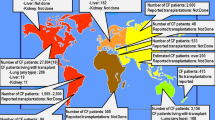Abstract
The incidence of airway colonization by Scedosporium apiospermum and of related sensitization was investigated prospectively in 128 patients with cystic fibrosis over a 5-year period, and results were compared with clinical data. Scedosporium apiospermum, recovered from sputum samples in 11 of 128 (8.6%) patients, was the most frequent filamentous fungus after Aspergillus fumigatus. Counterimmunoelectrophoresis, used to detect scedosporiosis serologically, was positive in 27 of 128 (21.1%) patients. The discrepancy between the mycological and serological results may be related to immune cross-reactions between Scedosporium apiospermum and Aspergillus fumigatus. However, symptoms of allergic bronchopulmonary disease were observed in two patients chronically colonized by Scedosporium apiospermum. The results clearly demonstrate that the frequency of this fungus is largely underestimated and that it may trigger an inflammatory response, thus suggesting a pathogenic role in patients with cystic fibrosis.
Similar content being viewed by others
Author information
Authors and Affiliations
Rights and permissions
About this article
Cite this article
Cimon, B., Carrère, J., Vinatier, J. et al. Clinical Significance of Scedosporium apiospermum in Patients with Cystic Fibrosis. EJCMID 19, 53–56 (2000). https://doi.org/10.1007/s100960050011
Issue Date:
DOI: https://doi.org/10.1007/s100960050011




